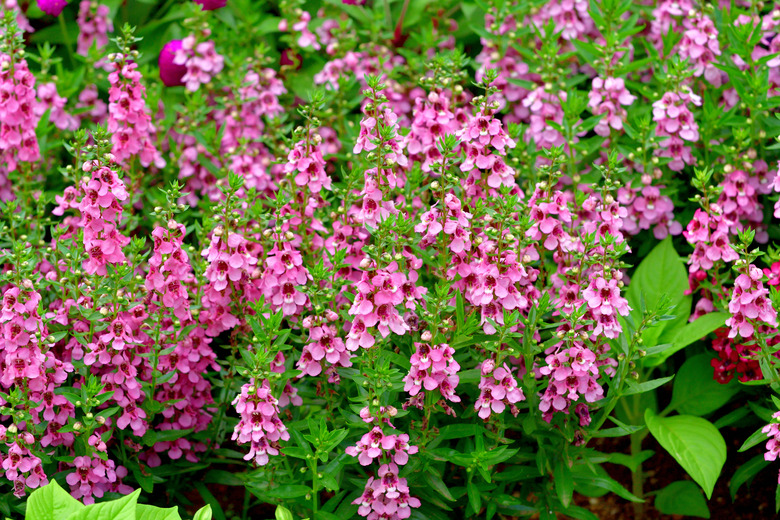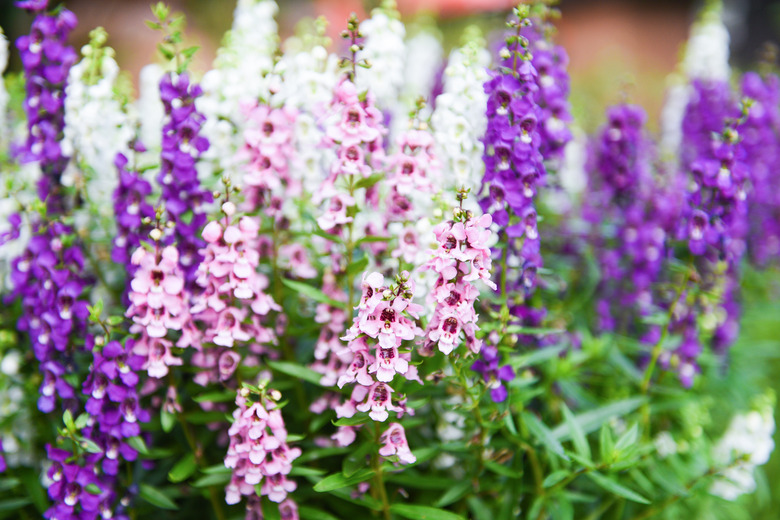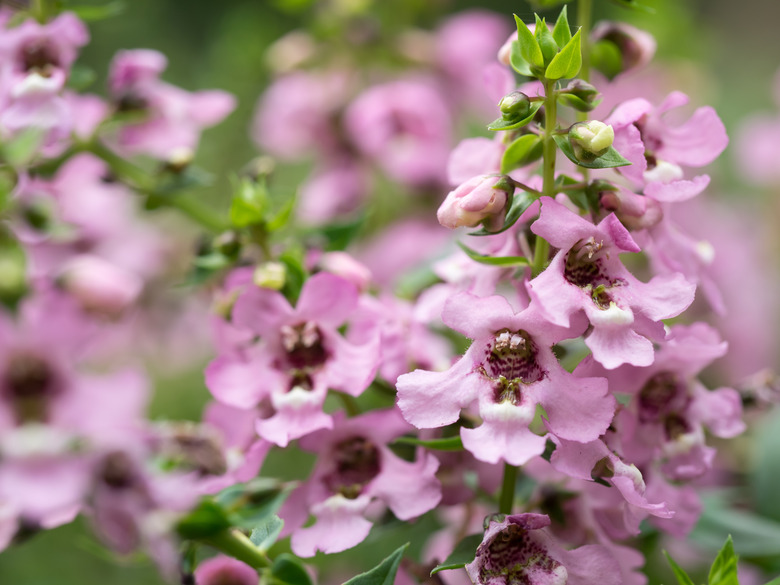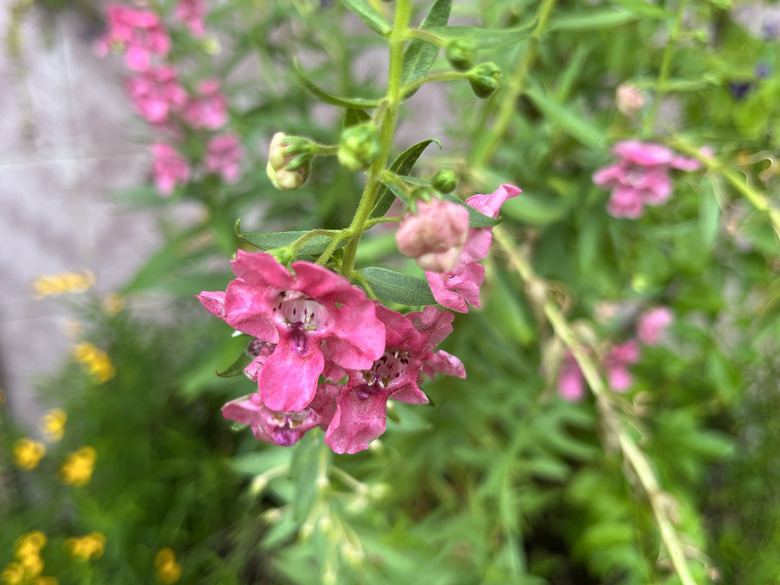How To Care For Angelonia Plants (Summer Snapdragons)
Showy, low-maintenance angelonia plants (Angelonia angustifolia) stand out among other perennial flowering plants with their intricate, two-lipped flowers, which earned them the common name "summer snapdragon." They grow as perennials within USDA plant hardiness zones 4a to 11b, but they are often grown as annual bedding plants or in containers outside their preferred USDA zones.
Angelonia plants grow fast, adapt to a wide range of growing conditions and need very little care once established. However, they will perform best and give the most dazzling flower display when planted and grown under the best possible conditions.
About Angelonia Plants
Angelonia plants bloom from mid-summer into early autumn, sending up 8-inch-tall spikes smothered in flowers. Each 3/4-inch flower has two lips with four to five fused petals, which give it an appearance very similar to the annual snapdragon (Antirrhinum spp.).
Angelonia flower spikes make excellent cut flowers, but they also attract hummingbirds and other pollinators to your garden when left to bloom in your flower beds.
Cultivars such as Serena® White (Angelonia angustifolia 'Serena® White', zones 8 to 11) produce creamy white flowers, while Serenita Lavender (Angelonia angustifolia 'Serenita Lavender,' zones 8 to 11) produces mauve blooms with a white lip. Other varieties within the common and widely grown Serena series produce purple flowers or even bicolor flower colors.
Planting Angelonia Plants
Learning how to plant angelonia comes down to knowing what conditions will produce the best flowering. Angelonia plants need bright light and warm temperatures at planting time and throughout the growing season. They grow best when planted in late spring well after the last frost when soil and air temperatures are warm.
Sun Exposure
Choose a planting site that provides full sun. Angelonia plants need at least six hours of direct sunlight each day and will tolerate summer heat without wilting, but some light midday shade is a good idea in hotter climates, as long as the plants receive morning and afternoon sun.
Soil and Drainage
Select a planting spot with **moist and well-draining soil.** If the soil is poor, amend the top 6 to 8 inches with a 2- to 3-inch layer of organic matter, such as aged compost.
Adding compost will help improve the soil, but it cannot provide good drainage. So be sure to choose a planting site where water soaks in or drains away following rain or heavy watering.
Spacing and Planting
**Space the plants 9 to 12 inches apart,** which is close enough to give a good display while allowing a little bit of airflow between the plants. Plant angelonia plants at the same depth they were growing in their original pot.
Spread a 2-inch layer of mulch between the plants, but leave a bit of space between the mulch and the base of the stems.
Potted Angelonia Ideas
Angelonia plants grow well in containers of all types, from large pots to hanging baskets to window boxes. Use good-quality potting soil when planting them and grow only one angelonia plant per each 9-inch pot. Position the pots in full sun with some light midday shade, especially in hot climates.
Caring for Angelonia Plants
Angelonia plants are very low maintenance whether you are growing them in a garden bed or in a container, although potted angelonias may need slightly more attention to ensure they don't dry out in their pots.
Watering Needs
Angelonia plants are relatively drought tolerant once established, but they need plenty of water when grown in full sun. At least 1 inch of water each week is required when growing them in the garden, with a little extra during times of high heat. Check the soil moisture with your finger and water only if the soil feels dry just below the surface.
Potted angelonia plants dry out quicker than those grown in the garden, so check the soil moisture often. Run water into the pot until a little drains from the bottom.
Fertilizer Requirements
Angelonias are moderate to heavy feeders. There are a few options when it comes to feeding angelonias.
Feed them weekly with 1/2 teaspoon of fertilizer dissolved in 1 gallon of water or use 1/4 teaspoon of fertilizer in 1 gallon of water at every watering. Use balanced 15-15-15 fertilizer or a low-nitrogen blooming fertilizer, such as 7-9-5.
Alternatively, you can feed the plants monthly using a light application of slow-release 10-5-10 fertilizer.
Pruning and Deadheading
Pruning is done to correct leggy growth in angelonia plants or to make them a more manageable size. Cut back the plant to the desired size at the end of the growing season and again in late winter to encourage bushy growth in spring.
Deadheading is not necessary to prolong blooming in angelonia flowers, but the spent flower stalks can be snipped off to improve the appearance of the plant.
Tip
Angelonia plants are relatively disease free, but it is still a good idea to wipe down your pruning shears with disinfectant to kill off any pathogens.
Troubleshooting Angelonia Plants
Angelonias rarely suffer from problems unless they are grown under the wrong conditions or are given the wrong care. Wet soil, whether from poor drainage or too much watering, can lead to root system problems, such as root rot. Growing these plants in well-draining soil and watering only when the soil feels dry will help prevent most root system problems.
Too-close planting can hamper airflow between the plants and will create the right conditions for powdery mildew. Spacing the plants 9 to 12 inches apart and watering at the base of the plant rather than from overhead will prevent fungal growth.



